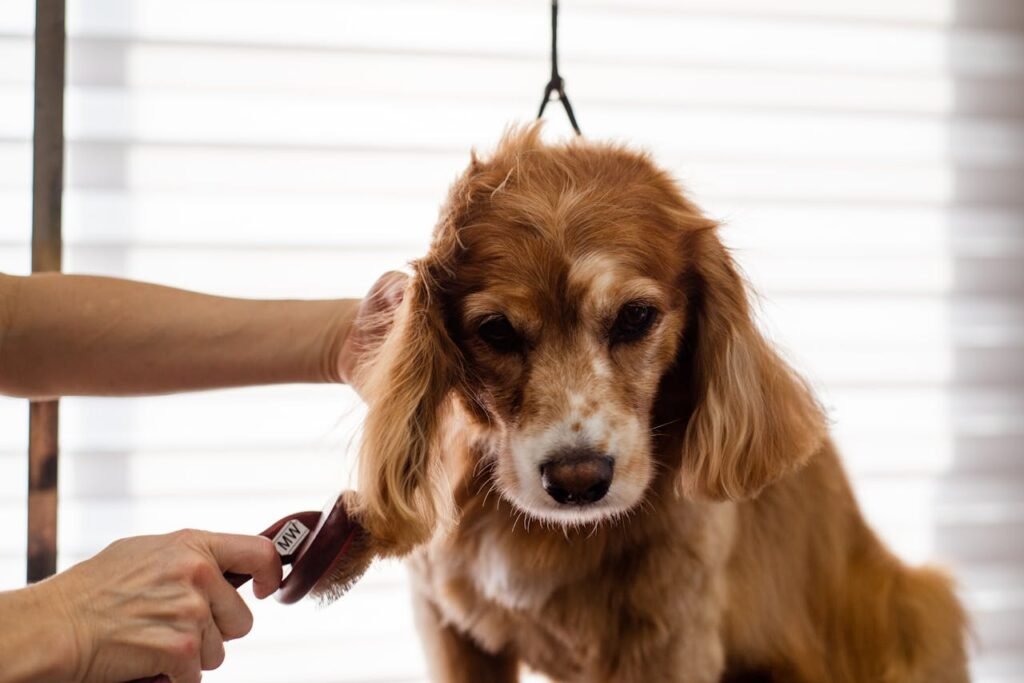How to Groom Your Dog at Home. Learn how To groom your dog at home easily! This simple guide covers brushing, bathing, & nail trimming, keeping your furry friend happy & healthy.
How To Groom Your Dog at Home
Understanding Your Dog’s Grooming Needs
Every breed possesses unique grooming requirements. Some dogs need frequent brushing, while others might require less. A dog’s coat type often dictates grooming frequency.
Different coat types include short, medium, long, & curly. For instance, short-haired breeds often require less grooming, but regular brushing aids in controlling shedding. Long-haired breeds, on other hand, demand more time & effort.
Being aware of your dog’s grooming needs helps build a strong bond. Spending quality time together during grooming fosters trust & understanding in your relationship.
Selecting Grooming Tools
Choosing appropriate grooming tools is essential for effective grooming sessions. Brushes, combs, nail clippers, & shampoos are fundamental items. Investing in quality tools can enhance overall grooming experience.
Brushes vary based on coat type. Slicker brushes work well for long-haired breeds, while bristle brushes suit short-haired dogs. Combs are effective for detangling knots & mats.
Additionally, ensure nail clippers are comfortable & safe for your dog. Some owners prefer electric nail trimmers, while others opt for traditional clippers. Find what suits your preference. Regular grooming can make this process easier.
Bathing Your Dog
Bathing plays a crucial role in grooming routine, but one must consider several factors. Frequency depends on breed, activity level, & coat type. Regular baths help maintain cleanliness while ensuring skin health.
Using appropriate shampoo for dogs prevents skin irritation. Formulations designed specifically for pets help maintain skin’s natural moisture balance. For specific skin conditions, consult a veterinarian before selecting a shampoo.
A calm environment during baths helps your dog feel comfortable. Using warm water & gently massaging shampoo into coat can turn bath-time into a pleasant experience. Check this video for helpful tips.
Brushing Techniques
Brushing your dog’s coat correctly can prevent matting & promote healthy skin. Start by gently brushing in direction of hair growth, which helps reduce discomfort. Be patient with your dog, as some might require more time To adapt.
In areas prone To tangles, use detangling spray for assistance. Work through mats slowly, using fingers or tools designed for removing tangles. Taking breaks during this process can help your dog remain calm.
Regular brushing not only maintains a healthy coat but also allows you To inspect skin & identify potential issues early. Keep an eye out for parasites or skin irritations that could develop.
Trimming Nails Safely
Nail trimming represents another essential grooming aspect. Overgrown nails can cause discomfort or even pain for your dog. Regular maintenance makes walking easier & more comfortable.
Identifying safe trimming points is vital. Avoid cutting too far, as this can lead To bleeding & pain. If unsure, consult your veterinarian or a professional groomer for guidance.
Using treats as positive reinforcement helps create a more pleasant experience. Associating nail trimming with rewards can ease anxiety. Regular practice will help both you & your dog become more comfortable with this task.
Cleaning Ears & Teeth
Keeping your dog’s ears clean prevents infections. Regular checks help identify dirt, wax buildup, or parasites. Utilizing a veterinarian-approved ear cleaner can promote ear health.
For dental care, brushing your dog’s teeth should become part of routine grooming. Special toothbrushes & toothpaste made for dogs provide safe options. Regular brushing helps prevent tartar buildup & bad breath.
Ensuring dental & ear hygiene contributes significantly towards your dog’s overall health. Regular attention helps avoid more serious issues down road & ensures comfort.
Dealing with Shedding
Some breeds shed more than others, creating challenges for pet owners. Regular grooming helps manage shedding, as it removes loose hair before it ends up on furniture or clothing. This also promotes skin health.
Using deshedding tools can significantly aid in reducing excess shedding. These tools effectively reach undercoat while minimizing discomfort for your dog during grooming sessions.
Engaging in regular grooming sessions coupled with proper nutrition can further reduce shedding. A healthy diet promotes overall coat health, directly influencing shedding amounts.
Managing Anxiety During Grooming
Many dogs experience anxiety during grooming sessions. Employing calming techniques can alleviate stress. Creating a positive, safe environment fosters comfort & reduces fear.
Using soothing voice tones, & treats as rewards, helps create a pleasant experience. Gradually introducing your dog To grooming tools can reduce fear of unfamiliar items.
Regular grooming can help desensitize your dog over time. Short sessions followed by rewards encourage familiarity & comfort with grooming activities, gradually easing anxiety levels.
Using Professional Grooming Services
Sometimes, despite your best efforts, professional grooming services might become necessary. For specific breeds with unique grooming needs, enlisting a groomer can prove beneficial.
Professional groomers possess experience & knowledge that ensure proper techniques are applied. They often have access To advanced grooming tools that might not be available at home.
Consulting with a professional also allows you To gain insight into your dog’s specific requirements. Observing their techniques can help improve your own grooming skills over time.
Understanding Common Grooming Mistakes
Amateur groomers often make simple mistakes that can affect overall results. One common mistake involves neglecting specific areas, leading To discomfort & irritation.
Using inappropriate tools can also have negative effects. Always select tools suitable for your dog’s coat type, size, & temperament. Ignoring these guidelines might lead To disappointing outcomes.
Additionally, rushing through grooming sessions can lead To unnecessary stress for both you & your dog. Taking time can foster a positive grooming environment & help improve techniques over time.
Features of Grooming at Home
- 🐕 Cost-effective
- 🏡 Convenience
- ❤️ Strengthens owner-pet bond
- ⏰ Flexible scheduling
- ✨ Customized grooming experience
Comparison of Grooming Methods
| Method | Cost 💰 | Convenience 🕒 | Effectiveness ✅ |
|---|---|---|---|
| Professional Grooming | Higher | Less flexible | Very effective |
| Home Grooming | Lower | Flexible | Effective |
| Mobile Grooming | Moderate | Convenient | Very effective |
My personal experiences with grooming my dog at home have been both rewarding & challenging. I have learned that patience & practice are key elements. Each session becomes an opportunity for bonding & understanding my dog’s needs better.
For additional resources on dog grooming, visit this link. For more advice & tips on pet care, check out Haven for Pet Care.
Learn how To groom your dog at home easily! This simple guide covers brushing, bathing, & nail trimming, keeping your furry friend happy & healthy.

What tools do I need To groom my dog at home?
To groom your dog at home, you will need a few essential tools. These typically include a slicker brush or a grooming comb for brushing their fur, nail clippers for trimming nails, & a dog shampoo for bathing. Additionally, you may want To have a clean towel for drying your dog, dog-safe ear cleaning solution, & possibly some dog-friendly deodorizing spray.
How often should I groom my dog?
The frequency of grooming depends on your dog’s breed, coat type, & lifestyle. For dogs with long or thick coats, grooming may be needed every few weeks To prevent matting. Short-haired dogs might only need grooming once a month. Regular brushing helps reduce shedding & keeps The coat healthy. Always observe your dog’s coat & adjust The grooming schedule as needed.
Can I bathe my dog at home, & how often is it necessary?
Yes, you can bathe your dog at home using dog-specific shampoos. Generally, dogs should be bathed every 4 To 6 weeks, but this can vary based on their activity level & breed. Dogs that spend a lot of time outdoors or have skin conditions may require more frequent baths, while less active dogs may need fewer baths. Always ensure you rinse thoroughly To remove all shampoo residue.
Conclusion
Grooming your dog at home can be a fun & rewarding experience for both you & your furry friend. By following The simple steps we discussed, like brushing, bathing, & nail trimming, you can keep your pup looking & feeling great. Remember To be gentle & patient, as it helps build trust between you & your dog. Regular grooming not only makes your pet look good but also keeps them healthy. So grab your grooming tools, put on some music, & enjoy this special time with your dog. Happy grooming!


